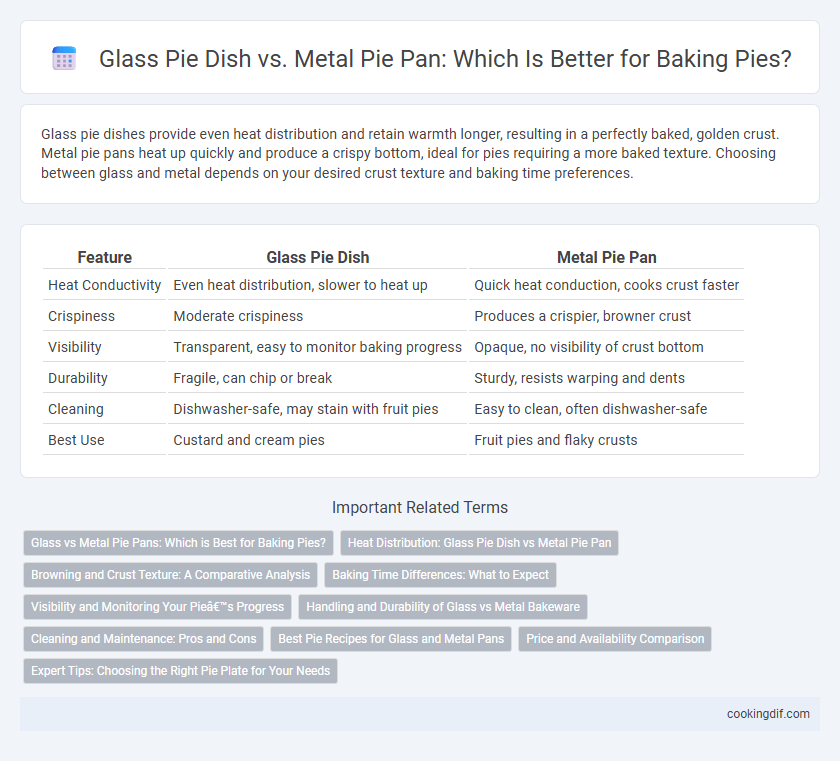Glass pie dishes provide even heat distribution and retain warmth longer, resulting in a perfectly baked, golden crust. Metal pie pans heat up quickly and produce a crispy bottom, ideal for pies requiring a more baked texture. Choosing between glass and metal depends on your desired crust texture and baking time preferences.
Table of Comparison
| Feature | Glass Pie Dish | Metal Pie Pan |
|---|---|---|
| Heat Conductivity | Even heat distribution, slower to heat up | Quick heat conduction, cooks crust faster |
| Crispiness | Moderate crispiness | Produces a crispier, browner crust |
| Visibility | Transparent, easy to monitor baking progress | Opaque, no visibility of crust bottom |
| Durability | Fragile, can chip or break | Sturdy, resists warping and dents |
| Cleaning | Dishwasher-safe, may stain with fruit pies | Easy to clean, often dishwasher-safe |
| Best Use | Custard and cream pies | Fruit pies and flaky crusts |
Glass vs Metal Pie Pans: Which is Best for Baking Pies?
Glass pie dishes provide even heat distribution and allow for easy monitoring of crust color during baking, making them ideal for achieving a golden, well-cooked crust. Metal pie pans, typically made from aluminum or steel, conduct heat faster and promote a crisper, flakier crust but require careful temperature control to avoid burning. Choosing between glass and metal depends on the desired crust texture and baking temperature, with glass suited for gentle, even baking and metal favored for quick, high-heat finishes.
Heat Distribution: Glass Pie Dish vs Metal Pie Pan
Glass pie dishes provide even heat distribution, ensuring the pie crust cooks uniformly and reduces the risk of hot spots. Metal pie pans, especially those made of aluminum or stainless steel, heat up more quickly and can achieve a crisper crust due to better heat conduction. Choosing between glass and metal affects baking time and crust texture, with metal pans favoring a faster bake and glass offering thorough, consistent heat.
Browning and Crust Texture: A Comparative Analysis
Glass pie dishes promote even browning through consistent heat retention, resulting in a golden, crisp crust that resists sogginess. Metal pie pans heat up quickly, producing a sharper, more defined crust edge with a slightly firmer texture. The choice between glass and metal significantly influences crust color and texture, with glass offering gentle caramelization and metal providing robust browning.
Baking Time Differences: What to Expect
Glass pie dishes typically require longer baking times compared to metal pie pans due to their lower thermal conductivity, which results in slower heat transfer and more even cooking. Metal pie pans heat up quickly, allowing pies to bake faster but with a higher risk of over-browning or burning the crust edges. Expect an approximate baking time difference of 5 to 10 minutes, with glass preferred for delicate fillings that benefit from gentle, consistent heat.
Visibility and Monitoring Your Pie’s Progress
Glass pie dishes offer superior visibility during baking, allowing you to monitor the pie's crust color and browning without opening the oven. This transparency helps prevent overbaking or undercooking by providing real-time visual cues on doneness. In contrast, metal pie pans obscure the crust's progress, requiring periodic opening of the oven and potentially disrupting heat distribution.
Handling and Durability of Glass vs Metal Bakeware
Glass pie dishes offer excellent heat retention and even cooking, with sturdy handles that provide secure grip, making them easier to handle when hot. Metal pie pans heat up quickly and cool down faster, but their thinner construction can warp or dent over time, reducing durability. Glass bakeware resists corrosion and scratching better than metal, ensuring long-term reliability in the kitchen.
Cleaning and Maintenance: Pros and Cons
Glass pie dishes offer the advantage of being non-porous, which prevents food odors and stains, making them easier to clean and maintain with simple hand washing or dishwasher use. Metal pie pans, especially those with non-stick coatings, can require more delicate care to avoid scratching and may need hand washing to preserve the surface, but they typically heat up faster and provide a crisper crust. Over time, glass remains resistant to rust and corrosion, whereas metal pans might show signs of wear, impacting long-term maintenance.
Best Pie Recipes for Glass and Metal Pans
Glass pie dishes provide even heat distribution, making them ideal for fruit pies such as apple and cherry, where a gentle bake enhances flavor and texture. Metal pie pans heat up quickly, perfect for achieving a flaky, golden crust in savory pies or buttery dessert pies like pecan or pumpkin. Selecting the right pan depends on the desired crust crispness and filling consistency to optimize baking results in popular pie recipes.
Price and Availability Comparison
Glass pie dishes typically range from $8 to $20 and are widely available in most supermarkets and kitchenware stores, offering a transparent design that allows for easy browning observation. Metal pie pans, often priced between $5 and $15, are commonly found in discount retailers and online platforms, favored for their durability and efficient heat conduction. Both options present affordable and accessible choices, with metal pans generally more budget-friendly but glass dishes popular for their aesthetic and versatility.
Expert Tips: Choosing the Right Pie Plate for Your Needs
Glass pie dishes provide even heat distribution and allow bakers to monitor crust browning, making them ideal for delicate fruit pies needing precise baking. Metal pie pans, typically aluminum or steel, conduct heat faster and yield a crispier crust, preferred for savory pies and those requiring a golden edge. Experts recommend selecting glass for visual baking control and metal for superior crust texture based on your pie type and baking preferences.
Glass pie dish vs metal pie pan for baking Infographic

 cookingdif.com
cookingdif.com